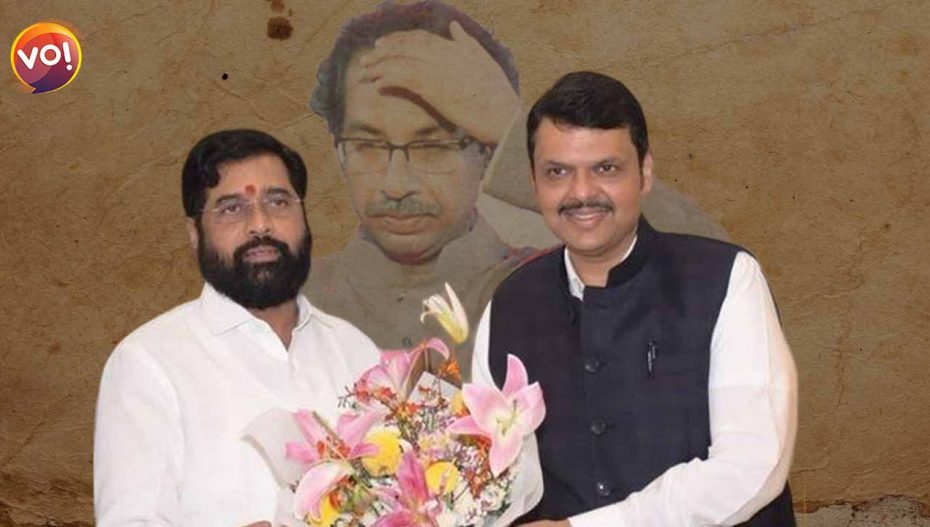The latest political saga in Maharashtra—which began with a rebellion in the Shiv Sena against Uddhav Thackeray, spearheaded by Eknath Shinde—climaxed in the elevation of Shinde as the chief minister and not Devendra Fadnavis, the former CM, pitched as the favourite of a large section of the BJP. Shinde, once critical to Uddhav for his political skills and organisational prowess, typifies the quintessential Sainik. He rose from the ranks, helped the Sena tide over dissidence outbursts in the past and filled in the vacuum caused by the departure of leaders such as Narayan Rane and Raj Thackeray and the untimely death of the Thane kingpin, Anand Dighe, his mentor. The BJP counts him as a “valuable” acquisition by the party for these reasons.
However, the BJP is confronted with important questions after its latest coup d’etat. The most crucial is whether Shinde will merge the breakaway faction he heads with the BJP. He enhanced its value by projecting it as the “real” Sena that was “true” to the founder Bal Thackeray’s ideals and legacy. Shinde went out of his way to paint Uddhav, Bal Thackeray’s scion, as a “dissembler” who treated the Sena as a personal fief and “compromised” its ideology by joining hands with parties with disparate agendas, away from Hindutva, like the Congress and the NCP. At this juncture, Shinde—who is determinedly working to vanquish Uddhav’s Sena as the grass root—would not want to amalgamate his entity with the BJP. That would weaken the raison d’etre of his rebellion and demoralise the cadre, the spin of the Sena. At least, he might not want to make a precipitate move before the BMC and Thane civic polls.
From the BJP’s standpoint the decision to anoint Shinde and not Fadnavis as the CM was politically prudent. In hindsight, it appears that Fadnavis—who assiduously worked to destabilise the Uddhav-led coalition from day one—had no clue that he was being passed over for the top job, although the reports had it that he worked in close tandem with Shinde to topple the MVA coalition. Amruta Fadnavis, Fadnavis’ high profile wife, tweeted a day earlier from London, “Performed special Puja! Prayed for stability and prosperity of Maharashtra. May we never forget the Mantra of democracy: People first, Party Next, Self Last.” Amruta’s tweet was posted soon after the Supreme Court ordered a floor test in the Maharashtra legislature that catalysed Uddhav’s move to put in his papers and clear the way for a BJP government.
Though Fadnavis pro-actively worked to weaken the MVA government, he lost some of his sheen after the 2019 Maharashtra elections. The BJP had lost 24 seats, down from 122 in 2014 to 105. It incurred major losses in Vidarbha, from where Fadnavis and the other Maharashtra leader and central minister, Nitin Gadkari hail. The NCP and the Congress gained at the BJP’s expense. Under Fadnavis’s leadership, the BJP also went down in western Maharashtra, in the significant sugar belt comprising Pune, Satara, Sangli, Kolhapur, Solapur and Ahmednagar.
Fadnavis’s inability to emerge as a pan-Maharashtra leader became evident. The lack of a strong Maratha, who could have helped the then BJP-Sena government tide over the tricky issue of reservation for the Marathas, was a drawback. The BJP inducted Narayan Rane, a former Sainik and a Maratha, whose departure from the Sena once cost the party votes in the Konkan region to which Rane belongs. The BJP gave Rane a Rajya Sabha berth and subsequently inducted him as a central minister, hoping his Maratha antecedent would help the party find the much-needed foothold in the rural areas where the NCP, under Sharad Pawar, was a big challenger.
That didn’t work. Rane was unable to go beyond Sindhudurg, his home base in Konkan and neutralise the influence that Sambhaji Raje, Rajya Sabha MP and a “descendant” of Chhatrapati Shivaji, commanded over the Marathas during the reservation agitation. In the meantime, the Sena regrouped itself in the Konkan region with the help of its local leaders and cadre who marginalized Rane.
The BJP hopes to make up the “Maratha shortfall” through Shinde who is engaged in a long-drawn battle with the NCP over Thane before the BMC and Thane civic polls. In the long run, it counted on Shinde to get the Maratha voters beyond Thane on its side.
Shinde’s anointment proved that the BJP resolutely shed its doubts over lateral entrants and their ability to lead its governments. The imperative of power brought about this important change in the BJP’s attitude to realpolitik. It helped that Shinde was part of the BJP’s old ally, the Sena, and wedded to the Hindutva ideology. Shinde joins a band of lateral entrants who made it to the top. These are Sarbananda Sonowal (former AGP), Himanta Biswa Sarma (former Congress), Basavaraj Bommai (former Janata Dal) and Manik Saha, also a former Congressman. Sarma has emerged as one of the BJP brass’s most dependable aides not only in the north-east from his perch in Guwahati but in the endeavour to pull down the MVA government recently. Despite the floods that caused havoc in Assam, Sarma ensured that the Sena rebels got a safe passage to Guwahati where they were lodged for more than a week. Bommai earned his spurs by implementing the RSS’s agenda in Karnataka.
With Fadnavis sworn in as the deputy CM, it has to be seen how the equation between him and Shinde pans out. But if there are glitches, the BJP’s central leadership is there to straighten these out because Maharashtra is too precious a state for PM Modi and HM Shah to let go.
Read More: BJP Springs Two Surprises: Shinde Is New Maharashtra CM & Fadnavis His Deputy










